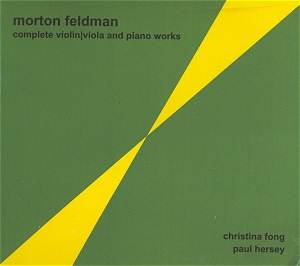
Morton Feldman’s star continues to rise in the years following his death in 1987. His music confuses some listeners, bores others, and challenges musicians with the prospect of performing mammoth works - in some instances running for five hours - that require utmost control and attention. This release from the minute label OgreOgress - so small they don’t give numbers to their releases - is a very important one for those who enjoy Feldman’s music. We now have several works that have not been recorded before.
One of these premier recordings is the opening [Sonata], composed in 1945 when Feldman was 19. It is a student piece and the most outwardly conventional of the works presented here, with three movements in fast/slow/fast sequence. Some would liken the sound of this piece to Bartók; for this reviewer, it calls up some of the Soviet composers of the 1920s and 1930s such as Roslavets or Lourié. The recording quality of this piece seems slightly muffled on headphones, but has very good presence on a living room system. The aesthetic of the recording suits the quiet later works especially well, with the microphone placement somewhat more distant than one would expect, allowing the ambience to act as a diffusing gauze over the ensemble.
The very short second work on the first disc, [Piece] of 1950, is sounds more like Feldman. The two instruments, interacting as if only by chance, play through their respective tones, the score bringing out many different colorations from the violin: harmonics, pizzicati, and bowed notes of widely varying pitch, as the piano plays chords of abruptly changing volume. Projection 4 and Extensions 1, the two following works, were written soon after [Piece], and are cut from the same cloth. The music here throws out spines; Feldman hasn’t yet taken to his later style of constant ppp dynamics, but over the course of these three pieces, one can see his development toward that end. The repetition or subtle colour changes of later Feldman are not here, but his sound-world is unmistakeable. The second piece from the Vertical Thoughts series, written just over a decade later than the Projection series and Extensions, has the breathless sense of suspension that marks much of Feldman’s later work.
Of the four pieces entitled The Viola in my Life, only the third is scored for viola and piano; the others are scored for the solo instrument with either chamber ensemble or orchestra. Here, the music, as well as the recording aesthetic, has receded even further from the footlights. The random sense of pitches and the occasionally confused sound has given way to a general motif of piano chords separated by rests.
Feldman, as some may already know, developed a fascination for oriental rugs, their patterns, their deviations, and this interest proved a springboard to his ideas of repetition, with slight variation, in the context of a larger — often much larger — work. Named after a mythical carpet, Spring of Chosroes is sparse, austere, contrasting with the image of a carpet of great intricacy and richness, yet corresponding in its subtly-varying repetition of motifs. Another find is the late piece [Composition] for solo violin of 1984 and the latest work presented in this release. It begins with alternating single notes and double-stops in a sort of breathing motif that the violinist carries throughout. This is a work of cold and quiet beauty which Christina Fong plays exceedingly well.
Of greatest interest to this reviewer are the two “For…” pieces that comprise the second disc of this collection. The first, For Aaron Copland, composed in 1981 and the much longer (by twelve times) For John Cage composed a year later, are haunting, bemusing, top-notch Feldman. John Cage bears a certain comparison to the Piano and String Quartet of 1985, but is far more varied regarding the repeated patterns and variation of motifs — Piano and String Quartet is a much more homogenous piece.
1 comment:
So, um, has this turned into the Critic's Choice blog?
Post a Comment